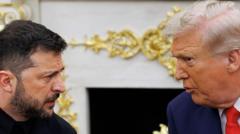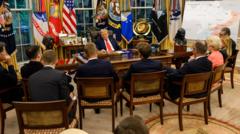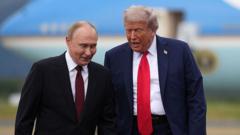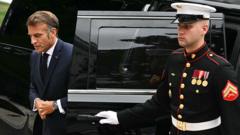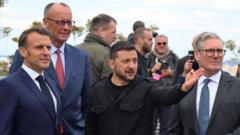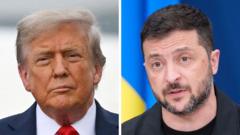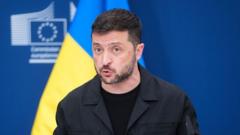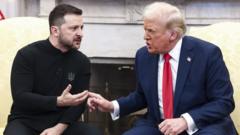U.S. President Donald Trump’s talks with Ukrainian President Volodymyr Zelensky and European leaders yielded insights on security guarantees, ceasefire debates, and potential negotiations with Russia.
**Diplomatic Dynamics: Key Insights from Recent Ukraine Negotiations in Washington**
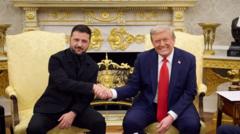
**Diplomatic Dynamics: Key Insights from Recent Ukraine Negotiations in Washington**
U.S. interactions with Ukraine and Europe raise questions amid ongoing conflict.
In a recent visit to the White House, President Volodymyr Zelensky of Ukraine engaged in discussions with U.S. President Donald Trump and several European leaders as part of efforts to address the ongoing war in Ukraine. This meeting followed a summit in Alaska between Trump and Russian President Vladimir Putin, which failed to reach any agreements on a ceasefire. Despite the optimistic rhetoric from some participants, no concrete commitments emerged from the Washington talks. Here are four key insights.
**1. Potential Meeting Between Putin and Zelensky?**
In his remarks following the summit, Trump suggested that he was initiating arrangements for a meeting between Putin and Zelensky. Trump's communication with the Russian leader lasted approximately 40 minutes on Monday, and he expressed optimism about potential negotiations involving both leaders alongside himself later. While Zelensky has long sought a direct meeting with Putin—believing that doing so would highlight Russia's reluctance for peace—the Kremlin has historically rejected direct engagement, suggesting that the elevation of representatives might be more appropriate for the negotiations.
**2. European Concerns on Ceasefire Stance**
Trump appeared to downplay the necessity of a ceasefire as a precursor to negotiations, differing from Ukraine's previous stance that emphasizes an end to hostilities before further discussions. German Chancellor Friedrich Merz voiced strong opposition to Trump’s comments, asserting that future discussions would be futile without a ceasefire in place. While Zelensky did not reiterate his calls for a ceasefire during the meeting, the divide remains clear between U.S. and European perspectives.
**3. Security Guarantees: Unclear Commitments**
During the discussions, Trump promised U.S. support for Ukraine's security within any peace agreement, although specific details were vague. He did not rule out involving U.S. military personnel in Ukraine, indicating that Europe served as the "first line of defense" while reiterating that the U.S. would engage in providing "good protection." Zelensky later highlighted a potential arms deal worth $90 billion with the U.S., mentioning vital military assets that would help Ukraine bolster its defenses against Russia.
**4. Zelensky's Diplomatic Approach**
In contrast to a more strained visit earlier this year, Zelensky opted for a cooperative demeanor, thanking his hosts multiple times during their meeting. Donning formal attire instead of his characteristic military outfit, he emphasized his diplomatic charm. Despite the flattery exchanged, European leaders maintained a tone of seriousness regarding the need for security guarantees in light of the ongoing conflict, underlining their collective vulnerability to Russian aggression.
As Zelensky continues to navigate these complex diplomatic waters, the unfolding situation emphasizes the intricate balance of support and negotiation that will likely shape the future trajectory of the Ukraine conflict.
**1. Potential Meeting Between Putin and Zelensky?**
In his remarks following the summit, Trump suggested that he was initiating arrangements for a meeting between Putin and Zelensky. Trump's communication with the Russian leader lasted approximately 40 minutes on Monday, and he expressed optimism about potential negotiations involving both leaders alongside himself later. While Zelensky has long sought a direct meeting with Putin—believing that doing so would highlight Russia's reluctance for peace—the Kremlin has historically rejected direct engagement, suggesting that the elevation of representatives might be more appropriate for the negotiations.
**2. European Concerns on Ceasefire Stance**
Trump appeared to downplay the necessity of a ceasefire as a precursor to negotiations, differing from Ukraine's previous stance that emphasizes an end to hostilities before further discussions. German Chancellor Friedrich Merz voiced strong opposition to Trump’s comments, asserting that future discussions would be futile without a ceasefire in place. While Zelensky did not reiterate his calls for a ceasefire during the meeting, the divide remains clear between U.S. and European perspectives.
**3. Security Guarantees: Unclear Commitments**
During the discussions, Trump promised U.S. support for Ukraine's security within any peace agreement, although specific details were vague. He did not rule out involving U.S. military personnel in Ukraine, indicating that Europe served as the "first line of defense" while reiterating that the U.S. would engage in providing "good protection." Zelensky later highlighted a potential arms deal worth $90 billion with the U.S., mentioning vital military assets that would help Ukraine bolster its defenses against Russia.
**4. Zelensky's Diplomatic Approach**
In contrast to a more strained visit earlier this year, Zelensky opted for a cooperative demeanor, thanking his hosts multiple times during their meeting. Donning formal attire instead of his characteristic military outfit, he emphasized his diplomatic charm. Despite the flattery exchanged, European leaders maintained a tone of seriousness regarding the need for security guarantees in light of the ongoing conflict, underlining their collective vulnerability to Russian aggression.
As Zelensky continues to navigate these complex diplomatic waters, the unfolding situation emphasizes the intricate balance of support and negotiation that will likely shape the future trajectory of the Ukraine conflict.

